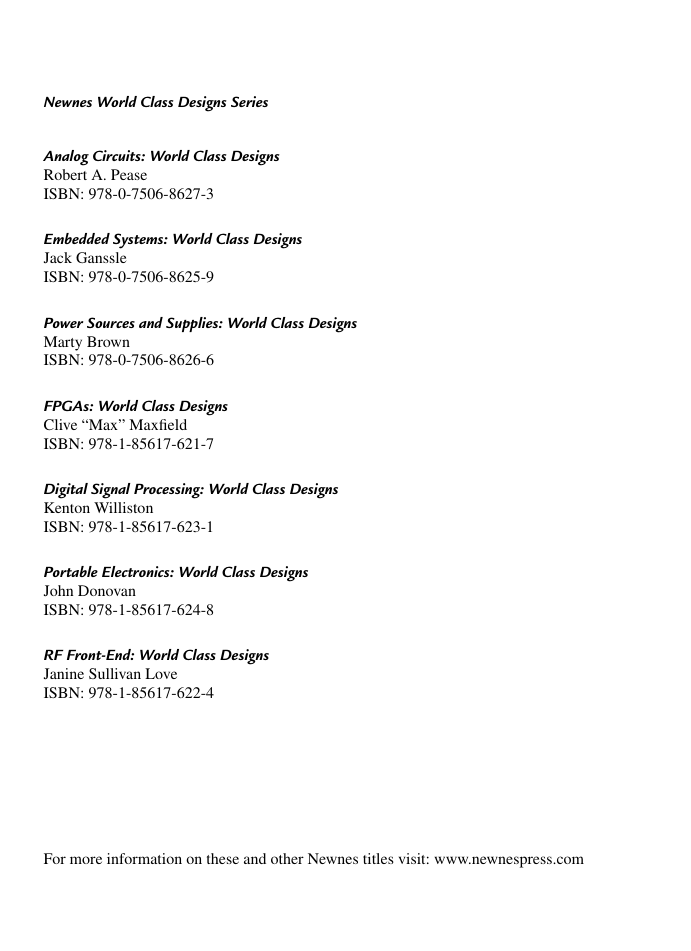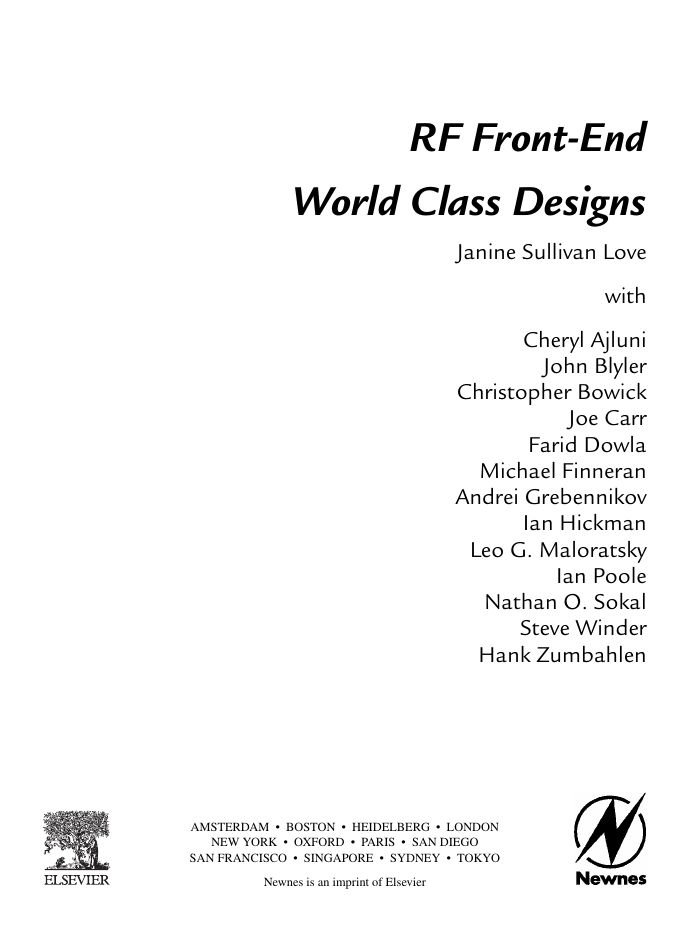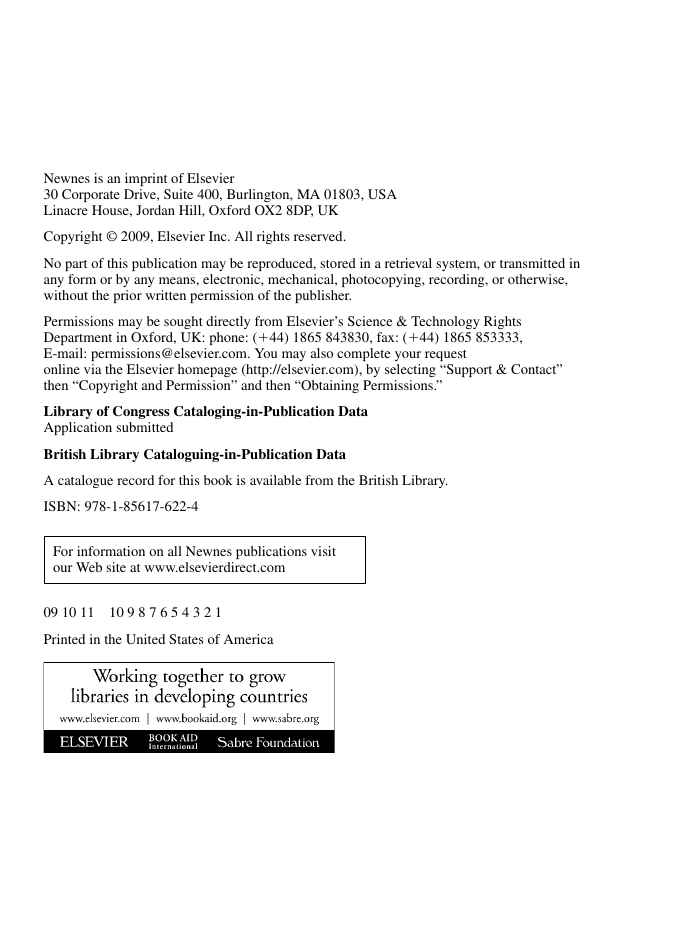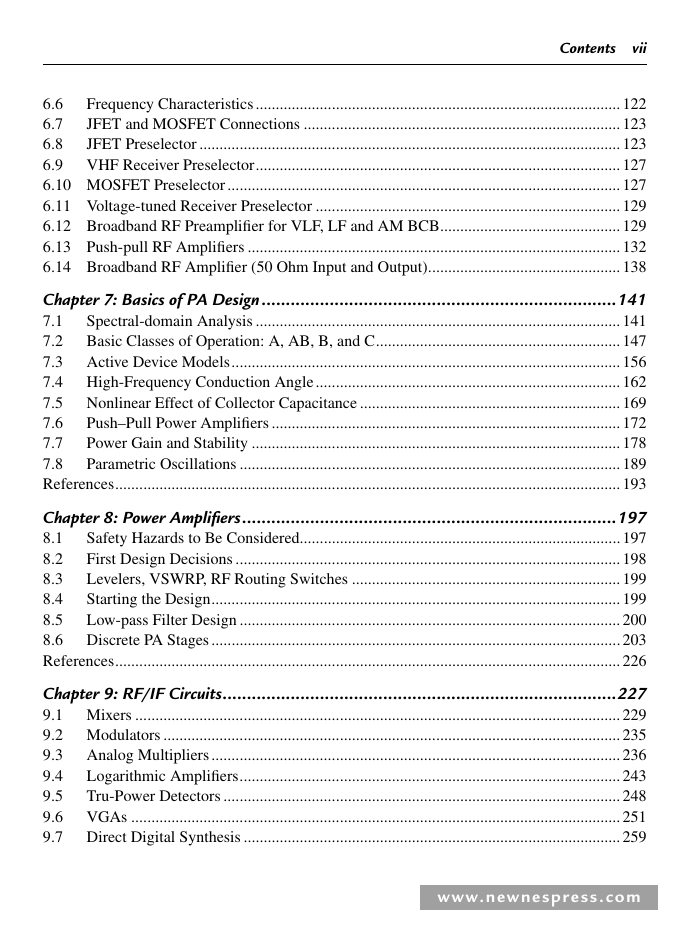RF Front-End World Class Designs
Copyright Page
Contents
Preface
About the Editor
About the Contributors
Chapter 1: Radio Waves and Propagation
1.1 Electric Fields
1.2 Magnetic Fields
1.3 Radio Waves
1.4 Frequency to Wavelength Conversion
1.5 Radio Spectrum
1.6 Polarization
1.7 How Radio Signals Travel
1.8 Refraction, Reflection and Diffraction
1.9 Reflected Signals
1.10 Layers above the Earth
1.11 Ground Wave
1.12 Skywaves
1.13 Distances and the Angle of Radiation
1.14 Multiple Reflections
1.15 Critical Frequency
1.16 MUF
1.17 LUF
1.18 Skip Zone
1.19 State of the Ionosphere
1.20 Fading
1.21 Ionospheric Disturbances
1.22 Very Low Frequency Propagation
1.23 VHF and Above
1.24 Greater Distances
1.25 Troposcatter
1.26 Sporadic E
1.27 Meteor Scatter
1.28 Frequencies above 3 GHz
Chapter 2: RF Front-End Design
2.1 Higher Levels of Integration
2.2 Basic Receiver Architectures
2.3 ADC'S Effect on Front-end Design
2.4 Software Defined Radios
2.5 Case Study—Modern Communication Receiver
Chapter 3: Radio Transmission Fundamentals for WLANs
3.1 Defining Transmission Capacity and Throughput
3.2 Bandwidth, Radios, and Shannon's Law
3.3 Bandwidth Efficiency
3.4 Forward Error Correction (FEC)
3.5 Radio Regulation
3.6 Licensed Versus Unlicensed Radio Spectrum
3.7 Unlicensed Spectrum in the Rest of the World
3.8 General Difficulties in Wireless
3.9 Basic Characteristics of 802.11 Wireless LANs
3.10 Conclusion
Chapter 4: Advanced Architectures
References
Chapter 5: RF Power Amplifiers
5.1 Power Amplifier Class of Operation
5.2 Conclusion
References
Chapter 6: RF Amplifiers
6.1 Noise and Preselectors/Preamplifiers
6.2 Amplifier Configurations
6.3 Transistor Gain
6.4 Classification by Common Element
6.5 Transistor Biasing
6.6 Frequency Characteristics
6.7 JFET and MOSFET Connections
6.8 JFET Preselector
6.9 VHF Receiver Preselector
6.10 MOSFET Preselector
6.11 Voltage-tuned Receiver Preselector
6.12 Broadband RF Preamplifier for VLF, LF and AM BCB
6.13 Push-pull RF Amplifiers
6.14 Broadband RF Amplifier (50 Ohm Input and Output)
Chapter 7: Basics of PA Design
7.1 Spectral-domain Analysis
7.2 Basic Classes of Operation: A, AB, B, and C
7.3 Active Device Models
7.4 High-Frequency Conduction Angle
7.5 Nonlinear Effect of Collector Capacitance
7.6 Push–Pull Power Amplifiers
7.7 Power Gain and Stability
7.8 Parametric Oscillations
References
Chapter 8: Power Amplifiers
8.1 Safety Hazards to Be Considered
8.2 First Design Decisions
8.3 Levelers, VSWRP, RF Routing Switches
8.4 Starting the Design
8.5 Low-pass Filter Design
8.6 Discrete PA Stages
References
Chapter 9: RF/IF Circuits
9.1 Mixers
9.2 Modulators
9.3 Analog Multipliers
9.4 Logarithmic Amplifiers
9.5 Tru-Power Detectors
9.6 VGAs
9.7 Direct Digital Synthesis
9.8 PLLs
Bibliography
Chapter 10: Filters
10.1 Classification
10.2 Filter Synthesis
10.3 LPFs
10.4 BPFs
References
Chapter 11: Transmission Lines and PCBs as Filters
11.1 Transmission Lines as Filters
11.2 Open-circuit Line
11.3 Short-circuit Line
11.4 Use of Misterminated Lines
11.5 Printed Circuits as Filters
11.6 Bandpass Filters
References
Chapter 12: Tuning and Matching
12.1 Vectors for RF Circuits
12.2 L-C Resonant Tank Circuits
12.3 Tuned RF/IF Transformers
12.4 Construction of RF/IF Transformers
12.5 Bandwidth of RF/IF Transformers
12.6 Choosing Component Values for L–C Resonant Tank Circuits
12.7 The Tracking Problem
12.8 The RF Amplifier/Antenna Tuner Problem
12.9 The Local Oscillator (LO) Problem
12.10 Trimmer Capacitor Method
12.11 Impedance Matching in RF Circuits
12.12 Transformer Matching
12.13 Resonant Transformers
12.14 Resonant Networks
12.15 Inverse-L Network
12.16 π-network
12.17 Split-capacitor Network
12.18 Transistor-to-Transistor Impedance Matching
Chapter 13: Impedance Matching
13.1 Background
13.2 The L Network
13.3 Dealing with Complex Loads
13.4 Three-element Matching
13.5 Low-Q or Wideband Matching Networks
13.6 The Smith Chart
13.7 Impedance Matching on the Smith Chart
13.8 Software Design Tools
13.9 Summary
Chapter 14: RF Power Amplifier Linearization Techniques
14.1 RF Amplifier Nonlinearity
14.2 Linearization Techniques
14.3 Digital Baseband Predistortion
14.4 Conclusion
References
Index
A
B
C
D
E
F
G
H
I
J
L
M
N
O
P
Q
R
S
T
U
V
W
X
Z
















 2023年江西萍乡中考道德与法治真题及答案.doc
2023年江西萍乡中考道德与法治真题及答案.doc 2012年重庆南川中考生物真题及答案.doc
2012年重庆南川中考生物真题及答案.doc 2013年江西师范大学地理学综合及文艺理论基础考研真题.doc
2013年江西师范大学地理学综合及文艺理论基础考研真题.doc 2020年四川甘孜小升初语文真题及答案I卷.doc
2020年四川甘孜小升初语文真题及答案I卷.doc 2020年注册岩土工程师专业基础考试真题及答案.doc
2020年注册岩土工程师专业基础考试真题及答案.doc 2023-2024学年福建省厦门市九年级上学期数学月考试题及答案.doc
2023-2024学年福建省厦门市九年级上学期数学月考试题及答案.doc 2021-2022学年辽宁省沈阳市大东区九年级上学期语文期末试题及答案.doc
2021-2022学年辽宁省沈阳市大东区九年级上学期语文期末试题及答案.doc 2022-2023学年北京东城区初三第一学期物理期末试卷及答案.doc
2022-2023学年北京东城区初三第一学期物理期末试卷及答案.doc 2018上半年江西教师资格初中地理学科知识与教学能力真题及答案.doc
2018上半年江西教师资格初中地理学科知识与教学能力真题及答案.doc 2012年河北国家公务员申论考试真题及答案-省级.doc
2012年河北国家公务员申论考试真题及答案-省级.doc 2020-2021学年江苏省扬州市江都区邵樊片九年级上学期数学第一次质量检测试题及答案.doc
2020-2021学年江苏省扬州市江都区邵樊片九年级上学期数学第一次质量检测试题及答案.doc 2022下半年黑龙江教师资格证中学综合素质真题及答案.doc
2022下半年黑龙江教师资格证中学综合素质真题及答案.doc